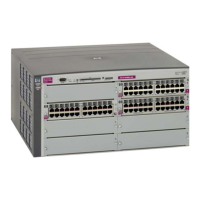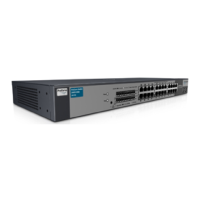OSPF 113
Figure 19 Injecting default routes
In more complex OSPF areas with multiple ABRs or ASBRs (such as area 0 and area 2 in the figure), there are
multiple routes leading from the area. In such areas, traffic for unrecognized destinations cannot tell which route leads
upstream without further configuration.
To resolve the situation and select one default route among multiple choices in an area, you can manually configure a
metric value on each ABR. The metric assigns a priority to the ABR for its selection as the priority default route in an
area. The following command is used for setting the metric value:
>> # /cfg/l3/ospf/default <metric value> <metric type (1 or 2)>
where <metric value> sets the priority for choosing this switch for default route. The value none sets no default and 1
sets the highest priority for default route. Metric type determines the method for influencing routing decisions for
external routes.
To clear a default route metric from the switch, use the following command:
>> # /cfg/l3/ospf/default none
Virtual links
Usually, all areas in an OSPF AS are physically connected to the backbone. In some cases where this is not possible,
you can use a virtual link. Virtual links are created to connect one area to the backbone through another non-
backbone area.
The area which contains a virtual link must be a transit area and have full routing information. Virtual links cannot be
configured inside a stub area or NSSA. The area type must be defined as transit using the following command:
>> # /cfg/l3/ospf/aindex <area index>/type transit
The virtual link must be configured on the routing devices at each endpoint of the virtual link, though they may
traverse multiple routing devices. To configure a switch as one endpoint of a virtual link, use the following command:
>> # /cfg/l3/ospf/virt <link number>/aindex <area index>/nbr <router ID>
where <link number> is a value between 1 and 3, <area index> is the OSPF area index of the transit area, and
<router ID> is the IP address of the virtual neighbor (nbr), the routing device at the target endpoint. Another router ID
is needed when configuring a virtual link in the other direction. To provide the switch with a router ID, see “Router
ID.”
For a detailed configuration example on Virtual Links, see “Example 2: Virtual Links.”
